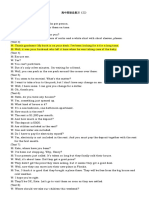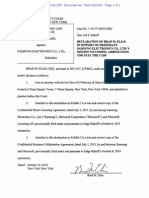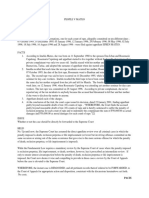Chapter29Notes_FA2024
Uploaded by
sirley1414Chapter29Notes_FA2024
Uploaded by
sirley1414Chapter 29 – Human Development
Notes
Development is the growth and differentiation of a zygote into an embryo, a fetus, and then a baby. Development continues
our entire lives even until the day we die.
__________________________________is the process of identical stem cells expressing different genes and becoming
specialized (different) from each other.
Oogenesis
During oogenesis, producing ova (eggs). At ovulation, an ovum consists of a corona radiata (follicle cells surrounding oocyte)
and zona pellucida (gelatinous layer inside corona).
Fertilization
__________________________ is the penetration of the oocyte by the sperm. Fusion of their nuclei known as
___________________. It must occur in the upper 1/3 of the uterine tube for the zygote to be developed enough to implant
a placenta into the endometrial wall. The single human cell is called a ______________________ and is __________ (2N).
What is capacitation?
When sperm penetrates oocyte, the ovum (egg) undergoes _______________ and the ___________________ hardens.
Prevents multiple sperm from entering the fertilized egg. If multiple sperm do penetrate it is called ______________ and the
zygote usually does not divide. Ovum completes meiosis II and is now the ovum is haploid (23 chromosomes).
Prenatal Development
___________________________ is the time between fertilization and birth. A typical human gestation is approximately 40
weeks (~9 months). It is divided into three trimesters.
• __________________: embryonic and early fetal development occurs. All major organ systems appear.
• ___________________: continued fetal development, all organ systems complete most of their development.
• ____________________: rapid fetal growth, organ systems become functional.
First Trimester
Complex changes and differentiation occur in the embryo. About 40% of embryos do not survive.
Major processes that occur during the first trimester:
1. _______________________________________ Cell division to produce multicellular stage called blastocyst.
2. ________________________________________Attachment of blastocyst into uterine wall.
3. ________________________________________ Formation of placenta.
4. _________________________________________Formation of the embryo.
BIOL 2402_AMC9 Anatomy and Physiology II 1
Cleavage and Blastocyst Formation:
The zygote undergoes mitosis and the first cell division or first _______________ (cleavage is another term for cell division).
This occurs about 30 hrs after fertilization. The two new cells are called _____________________ and will cleave
approximately every 10 – 12 hours. After approx. 3 days the embryo is a sold mass of cells called a ________________ and
enters the uterine cavity. By day 5 the blastomeres form a hollow ball of cells called a _____________________. The inner
cavity of the blastocyst is called the blastocoele. The blastocyst will develop two layers:
• _____________________ - an outer protective and supportive layer
• ______________________ – inner layer that develops into the embryo
Implantation:
About 7 days after fertilization the inner cells mass of the blastocyst begins to adhere to the uterine wall.
• Syncytial trophoblast - erodes a path for further implantation into the endometrium.
• Cellular trophoblast forms - creates a region of tissue with spaces called lacunae that allow for maternal blood to
supply the embryo with nutrients. The trophoblast will grow finger-like villi to increase surface area for the exchange
of gases, nutrients, and wastes with the mother’s blood supply. This structure becomes the
_______________________.
Blastodisc Formation:
After implantation the top layer of the inner cell mass separates from the trophoblast and creates a space called the
_________________________. The inner cell mass organizes into a _______________ containing two layers, the __________
on top facing amniotic cavity, and a _______________ below it facing the blastocoele. The blastodisc is the
__________________.
Gastrulation & Germ Layer Formation:
_____________________________ is the movement of cells to produce embryonic cell layers called germ layers. All human
tissues develop from these germ layers. At around day 12 a line called the primitive streak forms in the middle of the
blastodisc. Cells migrate between the epiblast and hypoblast and produce a third layer. These three germ layers are the
ectoderm, endoderm, and the mesoderm.
• ______________________________develops into skin, hair, nails, and nervous system
• ______________________________develops into digestive and respiratory system
• ______________________________develops into muscle, bone, cartilage, and cardiovascular tissue
Formation of Extraembryoinc Membranes
Four membranes lie outside the embryonic disc and function to protect and nourish the embryo as it develops into a fetus.
**Note: You are not responsible for knowing which germ layers lead to the production of these structures.
1. Yolk sac: It is the early site of ____________formation. It becomes nonfunctional part of umbilical cord.
2. Amnion: The “water bag” is a thin protective membrane filled with amniotic fluid that acts like a shock absorber to
protect the fetus.
BIOL 2402_AMC9 Anatomy and Physiology II 2
3. Allantois: Forms part of umbilical cord.
4. Chorion: Surrounds embryo and forms fetal part of placenta.
Placentation
The fetal portion of the placenta is formed by the chorion. Chorionic villi grow into the endometrium and erode blood vessels
and leak maternal blood into lacunae to provide oxygen and nutrients.
• ________________________ - vascular connection between embryo and placenta
• _________________________ - site where yolk sac is attached to embryo
• __________________________ - the fetal connection to the placenta. Composed of the yolk and body stalks.
Embryogenesis
The embryo becomes physically and developmentally separated from the blastodisc and develops a head fold and a tail fold.
The embryo now has definite ventral and dorsal surfaces and right and left sides. _______________________ is the formation
of organs.
Second and Third Trimester
By the start of the second trimester all major organ systems are forming. The developing embryo is now called a _________.
The fetus continues to grow and organs/organ systems continue to develop.
• In the third trimester all organ systems are functional.
• Rapid fetal growth occurs
• Fetus triples in size and increases in weight about 50 times.
• Around 40 weeks of gestation labor contractions will begin in the uterine wall. False labor is due to muscle spasms
during late pregnancy. True labor is physiological labor that results in delivery.
Pregnancy and Maternal Systems
During pregnancy the developing fetus is dependent upon maternal organs for nourishment, respiration, and waste removal.
Changes in maternal physiology accomplish the task of “eating, breathing, and excreting for two.” During this time the
following physiological changes occur:
• Respiratory rate and tidal volumes increase
• Maternal blood volume increases
• Maternal nutritional requirements increase 10 – 30%
• Glomerular filtration rate increases by 50%
• Uterus increases in size – will contain 5 liters of amniotic fluid
BIOL 2402_AMC9 Anatomy and Physiology II 3
Labor and Delivery
• Giving birth is called ________________________. Labor contractions begin at the top of the uterus and spread like a
wave towards the ___________, moving the fetus toward the cervical canal.
• Once contractions begin a positive feedback loop begins and increase the frequency and force of the contractions.
The hormone _________________ causes the symphysis pubis to become more flexible and increases estrogen levels.
• Stretching of the uterus and cervix due to the fetus stimulates the release of ____________________.
___________________ and _____________________ increase uterine contractions.
• Fetal factors, placental factors, maternal oxytocin, distortion of the myometrium and prostaglandin production can all
lead to increased excitability of the myometrium and lead to labor contractions.
Three Stages of Labor
1. ___________________________: begins at the onset of true labor and the cervix will dilate completely to 10cm. The
fetus begins to travel down the cervical canal. Contractions occur every 10-30 minutes. Amniotic membrane breaks
(water breaks).
2. ___________________________ : cervix is fully dilated and fetus passes through the cervical and vaginal canal.
Usually lasts less than 2 hours. Delivery of the newborn into the outside world completes the expulsion stage. An
episiotomy is the surgical cutting of the perineum to prevent tearing.
3. ____________________________: uterine contractions tear the connections between endometrium and placenta.
Occurs within 1 hour of delivery (afterbirth).
Multiple Births
• ______________________: two eggs ovulated and fertilized with separate placentas (fraternal twins)
• ______________________: one egg is fertilized, blastomeres separate at first cleavage and two embryos form and
share the same placenta (identical twins).
• Conjoined twins: blastodisc that has separated but still attached at a certain point.
Postnatal Development
Individual pass through a series of stages during life: neonate, infant, childhood, adolescence, maturity (adulthood),
senescence.
Neonatal Period - From birth to one month. Physiology changes include:
• Neonate can’t control body temp until adipose tissue develops.
• Powerful inspiratory movement expands lungs with first breath.
• Once lungs expand circulatory pattern changes, foramen ovale closes (now the fossa ovalis) and the ductus arteriosus
closes (now the ligamentum arteriosum).
• Digestive system eliminates materials (bile, mucus, epithelium) as meconium.
• Kidneys begin to filter blood
BIOL 2402_AMC9 Anatomy and Physiology II 4
You might also like
- General Embryology Lecture 1 and 2 - Day 1-Third WeekNo ratings yetGeneral Embryology Lecture 1 and 2 - Day 1-Third Week141 pages
- Reproductive System HSB[1] (AutoRecovered)No ratings yetReproductive System HSB[1] (AutoRecovered)9 pages
- Grade 10 HSB Handout on Reproduction in HumansNo ratings yetGrade 10 HSB Handout on Reproduction in Humans16 pages
- Principles of Normal Development in Infancy and Early PregnancyNo ratings yetPrinciples of Normal Development in Infancy and Early Pregnancy14 pages
- General Embryology Lecture 1 and 2 - Day 1-Third WeekNo ratings yetGeneral Embryology Lecture 1 and 2 - Day 1-Third Week143 pages
- Worksheet. Chapter 12. Human Reproductive SystemNo ratings yetWorksheet. Chapter 12. Human Reproductive System2 pages
- General Embryology Lecture 1 and 2 - Day 1-Third WeekNo ratings yetGeneral Embryology Lecture 1 and 2 - Day 1-Third Week142 pages
- Human Reproduction and Development (My Copy)No ratings yetHuman Reproduction and Development (My Copy)24 pages
- Individual Assignment Anatomy by DerertuNo ratings yetIndividual Assignment Anatomy by Derertu10 pages
- Fertilization,_implantation,_placental_development_and_functions_2No ratings yetFertilization,_implantation,_placental_development_and_functions_221 pages
- Final Module 9 Prenatal Development.activity 2(2)No ratings yetFinal Module 9 Prenatal Development.activity 2(2)5 pages
- #01_ANAT 203_Introduction to Embryology 2No ratings yet#01_ANAT 203_Introduction to Embryology 245 pages
- Unit 2 - Fertilization, Impantation, Development of Placenta and Its Function, Abnormality100% (1)Unit 2 - Fertilization, Impantation, Development of Placenta and Its Function, Abnormality62 pages
- University of Easetrn Philippines Laoang Campus Midterm ExaminationNo ratings yetUniversity of Easetrn Philippines Laoang Campus Midterm Examination4 pages
- Performance-Related and Skill-Based Pay: An Introduction: ACT/EMP/17No ratings yetPerformance-Related and Skill-Based Pay: An Introduction: ACT/EMP/1744 pages
- Redacted Version of Microsoft's 2011 Contracts With Samsung PDF100% (1)Redacted Version of Microsoft's 2011 Contracts With Samsung PDF71 pages
- Ion Exchange Demineralizers: Big Problems, Small SolutionsNo ratings yetIon Exchange Demineralizers: Big Problems, Small Solutions10 pages
- SPE-1167-Wettability of Porous Rock by Amott, 1960)No ratings yetSPE-1167-Wettability of Porous Rock by Amott, 1960)7 pages
- General Embryology Lecture 1 and 2 - Day 1-Third WeekGeneral Embryology Lecture 1 and 2 - Day 1-Third Week
- Principles of Normal Development in Infancy and Early PregnancyPrinciples of Normal Development in Infancy and Early Pregnancy
- General Embryology Lecture 1 and 2 - Day 1-Third WeekGeneral Embryology Lecture 1 and 2 - Day 1-Third Week
- General Embryology Lecture 1 and 2 - Day 1-Third WeekGeneral Embryology Lecture 1 and 2 - Day 1-Third Week
- Fertilization,_implantation,_placental_development_and_functions_2Fertilization,_implantation,_placental_development_and_functions_2
- Unit 2 - Fertilization, Impantation, Development of Placenta and Its Function, AbnormalityUnit 2 - Fertilization, Impantation, Development of Placenta and Its Function, Abnormality
- University of Easetrn Philippines Laoang Campus Midterm ExaminationUniversity of Easetrn Philippines Laoang Campus Midterm Examination
- Performance-Related and Skill-Based Pay: An Introduction: ACT/EMP/17Performance-Related and Skill-Based Pay: An Introduction: ACT/EMP/17
- Redacted Version of Microsoft's 2011 Contracts With Samsung PDFRedacted Version of Microsoft's 2011 Contracts With Samsung PDF
- Ion Exchange Demineralizers: Big Problems, Small SolutionsIon Exchange Demineralizers: Big Problems, Small Solutions
- SPE-1167-Wettability of Porous Rock by Amott, 1960)SPE-1167-Wettability of Porous Rock by Amott, 1960)





























































































